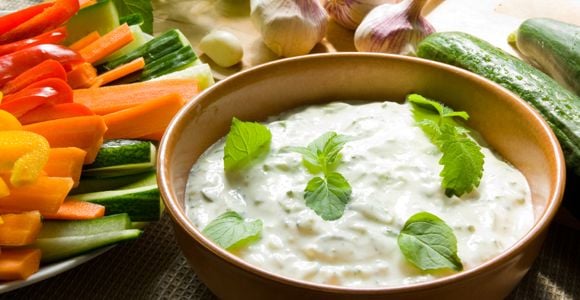Summer produce is starting to go bad and autumn's harvest is not far from ripening, so what better way to use and enjoy the seasonal produce than with a variety of dips and spreads? Healthy dips and spreads can be a great vehicle for an array of crisp, juicy fruits and vegetables, and they're a great party pleaser. But all too often, dips can be loaded with fat and calories. Never fear--we ve got easy tips and a few simple recipes to help.
First, choose a low-fat or fat-free "base" rather than the typical main ingredients for dips and spreads, which usually consist of full-fat sour cream, mayonnaise, cream cheese, etc. Opt for reduced-fat or fat-free versions and add flavorful herbs and spices. Second, watch portion sizes. The typical portion size for a dip or spread is two to four tablespoons, but we often end up eating significantly more than that, especially if we linger around the dip bowl and dip directly from the bowl rather than spooning a small dollop on our plates.
If you don't have a blender or food processor, don't worry. Simply mash the more solid ingredients using a potato masher or fork and then blend the mixture with a spoon until smooth.
Party-Pleasing Pumpkin Dip
In a blender or food processor, mix one 15-ounce can of pumpkin, one cup reduced-fat or fat-free cream cheese (softened), one teaspoon ground cinnamon, and ¼ teaspoon ground nutmeg. Serve with sliced apples or pears, or spread onto whole-grain toast or waffles.
A Lotta Ricotta Fruit Dip
In a blender or food processor, blend eight ounces of low-fat ricotta cheese, ½ cup nonfat vanilla yogurt (look for a variety with less sugar), and three tablespoons of fruit jam or preserves. Serve this creamy dip with your favorite sliced fruit.
Lean Mean Bean Dip
In a food processor or blender, combine one 15 ½-ounce can of beans (any variety will work), one clove of minced garlic, ¼ cup water, one tablespoon canola oil, ½ teaspoon salt, and ½ teaspoon ground black pepper. For an extra kick, add in a dash of cayenne pepper, or mix in some salsa. For added creaminess, mix in ¼ cup plain nonfat yogurt. Pair with sliced vegetables or whole-wheat crackers, or use as a substitute for mayonnaise.
Easy Hummus
Using a food processor or blender, combine one 15 ½-ounce can of chickpeas (garbanzo beans), two tablespoons tahini (sesame paste), two tablespoons olive oil, two cloves of minced garlic, four to five tablespoons lemon juice, and ¼ cup water. Puree until smooth, adding more water if necessary. Season to your taste with salt, pepper, cumin, cayenne pepper, or fresh herbs (oregano, basil, cilantro or parsley). Serve with cut-up vegetables or whole-grain pita wedges.
Fast Veggie Dip
Blend together ½ cup of nonfat plain yogurt, ½ cup low-fat or fat-free sour cream, and one tablespoon of your favorite version of salt-free seasoning mix (such as Mrs. Dash, which has a wide variety of flavors). Serve this quick, protein-packed dip with sliced vegetables, or use it to jazz up your sandwiches or wraps.
Healthy Honey Mustard
Combine ½ cup plain nonfat yogurt, one tablespoon Dijon mustard, and one tablespoon of honey and stir until well blended. This lightened-up version has significantly less fat than most traditional honey mustard dips. Serve with cut-up vegetables or use as a tangy spread on sandwiches or wraps.
Kari Hartel, RD, LD is a Registered, Licensed Dietitian and freelance
writer based out of St. Louis, MO. Kari is passionate about nutrition
education and the prevention of chronic disease through a healthy diet
and active lifestyle. Kari holds a Bachelor of Science in Dietetics from
Southeast Missouri State University and is committed to helping people
lead healthy lives. She completed a yearlong dietetic internship at OSF
St. Francis Medical Center in Peoria, IL, where she worked with a
multitude of clients and patients with complicated diagnoses. She
planned, marketed, and implemented nutrition education programs and
cooking demonstrations for the general public as well as for special
populations, including patients with cancer, heart disease, diabetes,
Alzheimer's disease, obesity, and school-aged children. Contact Kari at [email protected].



